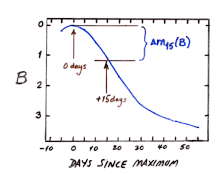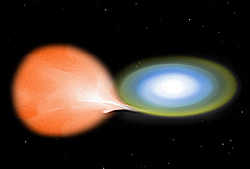
A nova is a transient astronomical event that causes the sudden appearance of a bright, apparently "new" star that slowly fades over weeks or months. All observed novae involve white dwarfs in close binary systems, but causes of the dramatic appearance of a nova vary, depending on the circumstances of the two progenitor stars. The main sub-classes of novae are classical novae, recurrent novae (RNe), and dwarf novae. They are all considered to be cataclysmic variable stars.

A supernova is a powerful and luminous explosion of a star. A supernova occurs during the last evolutionary stages of a massive star, or when a white dwarf is triggered into runaway nuclear fusion. The original object, called the progenitor, either collapses to a neutron star or black hole, or is completely destroyed to form a diffuse nebula. The peak optical luminosity of a supernova can be comparable to that of an entire galaxy before fading over several weeks or months.
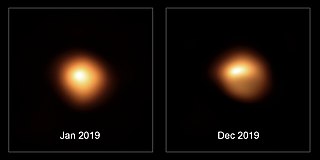
A variable star is a star whose brightness as seen from Earth changes systematically with time. This variation may be caused by a change in emitted light or by something partly blocking the light, so variable stars are classified as either:

In astronomy, a light curve is a graph of the light intensity of a celestial object or region as a function of time, typically with the magnitude of light received on the y-axis and with time on the x-axis. The light is usually in a particular frequency interval or band.

The cosmic distance ladder is the succession of methods by which astronomers determine the distances to celestial objects. A direct distance measurement of an astronomical object is possible only for those objects that are "close enough" to Earth. The techniques for determining distances to more distant objects are all based on various measured correlations between methods that work at close distances and methods that work at larger distances. Several methods rely on a standard candle, which is an astronomical object that has a known luminosity.
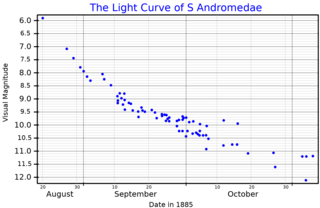
SN 1885A was a supernova in the Andromeda Galaxy, the only one seen in that galaxy so far by astronomers. It was the first supernova ever seen outside the Milky Way, though it was not appreciated at the time how far away it was. It is also known as "Supernova 1885".

SN 1572, or B Cassiopeiae, was a supernova of Type Ia in the constellation Cassiopeia, one of eight supernovae visible to the naked eye in historical records. It appeared in early November 1572 and was independently discovered by many individuals.

A Type Ia supernova is a type of supernova that occurs in binary systems in which one of the stars is a white dwarf. The other star can be anything from a giant star to an even smaller white dwarf.

The known history of supernova observation goes back to 1006 AD. All earlier proposals for supernova observations are speculations with many alternatives.

Type Ib and Type Ic supernovae are categories of supernovae that are caused by the stellar core collapse of massive stars. These stars have shed or been stripped of their outer envelope of hydrogen, and, when compared to the spectrum of Type Ia supernovae, they lack the absorption line of silicon. Compared to Type Ib, Type Ic supernovae are hypothesized to have lost more of their initial envelope, including most of their helium. The two types are usually referred to as stripped core-collapse supernovae.

A Type II supernova or SNII results from the rapid collapse and violent explosion of a massive star. A star must have at least eight times, but no more than 40 to 50 times, the mass of the Sun (M☉) to undergo this type of explosion. Type II supernovae are distinguished from other types of supernovae by the presence of hydrogen in their spectra. They are usually observed in the spiral arms of galaxies and in H II regions, but not in elliptical galaxies; those are generally composed of older, low-mass stars, with few of the young, very massive stars necessary to cause a supernova.
SN 2005gj was a supernova located approximately 864 million light years away from Earth. It was discovered on September 27, 2005, by the Sloan Digital Sky Survey and the Nearby Supernova Factory. 2005gj was noted because it had qualities of both type Ia and type IIn supernovae, and because hydrogen emission lines were found in its spectrum. These hydrogen lines, which were found on the spectrum at redshift z=0.0613, are thought to be indicative of interactions with a circumstellar medium by the supernova's ejected matter or white dwarf progenitor. Such emission lines are extremely rare in Type Ia supernovae – only one other Type Ia, SN 2002ic, has been observed to exhibit the same properties. However, 2005gj's CSM interaction was much stronger and more clearly observed than 2002ic's. The mass-loss history 2005gj's hydrogen lines suggest has been cited as evidence that luminous blue variable (LBV) hypergiants can be progenitors of thermonuclear supernovae.
SN 2002cx is a peculiar type Ia supernova. It was discovered in May 2002 by a team of researchers from LBL. It behaved differently from normal type Ia supernovae, and differently from several other previously observed peculiar type Ia supernovae including SN 1991T and SN 1991bg.

SN 1998aq is a nearby supernova located in the intermediate spiral galaxy NGC 3982, offset 18″ west and 7″ of the galactic nucleus. It was discovered April 13, 1998 by amateur astronomer Mark Armstrong and was confirmed by fellow British amateur Ron Arbour; both members of the U.K. Supernova/Nova Patrol. The event was not visible on a prior check by Armstrong made April 7. It reached peak brightness on April 27, and 15 days later had declined by 1.14 magnitudes in the B (blue) band.
SN 1972E was a supernova in the galaxy NGC 5253 that was discovered 13 May 1972 with an apparent B magnitude of about 8.5, shortly after it had reached its maximum brightness. In terms of apparent brightness, it was the second-brightest supernova of any kind of the 20th century. It was observed for nearly 700 days, and it became the prototype object for the development of theoretical understanding of Type Ia supernovae.

SN 2014J was a type-Ia supernova in Messier 82 discovered in mid-January 2014. It was the closest type-Ia supernova discovered for 42 years, and no subsequent supernova has been closer as of 2023. The supernova was discovered by chance during an undergraduate teaching session at the University of London Observatory. It peaked on 31 January 2014, reaching an apparent magnitude of 10.5. SN 2014J was the subject of an intense observing campaign by professional astronomers and was bright enough to be seen by amateur astronomers.

NGC 3631 is a spiral galaxy located in the constellation Ursa Major. It is located at a distance of about 35 million light years from Earth, which, given its apparent dimensions, means that NGC 3631 is about 60,000 light years across. It was discovered by William Herschel on April 14, 1789. It is a grand design spiral galaxy seen face on.

SN 2022jli is a Type Ic supernova discovered in 2022 in the spiral galaxy NGC 157 at a distance of about 23 Mpc. The light curve of the supernova exhibited oscillations that are interpreted as an interaction of a companion star of the star that exploded with a compact object, probably a neutron star or a black hole.
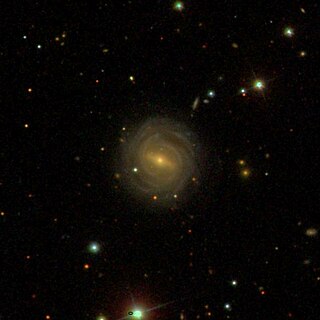
NGC 7222 is a large barred spiral galaxy with a ring structure, located in the constellation Aquarius. It is located 570 million light-years away from the Solar System and was discovered by German astronomer, Albert Marth on August 11, 1864.
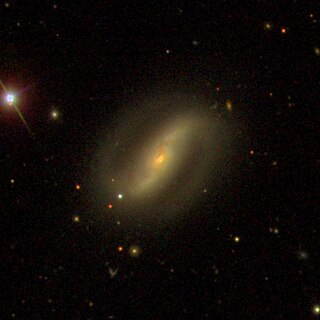
NGC 4332 is a barred spiral galaxy and a starburst galaxy located 128 million light-years away in the constellation Draco. The galaxy was discovered by astronomer William Herschel on March 20, 1790. NGC 4332 is host to a supermassive black hole with an estimated mass of 9.5×107 solar masses.
